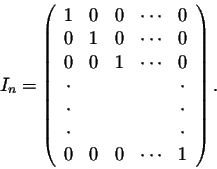
0.6
I + 0.3 S
while the population of the suburbs is
0.4
I + 0.7 S
After two years, the population of the inner city is
0.6
(0.6 I + 0.3 S) + 0.3 (0.4 I + 0.7 S)
and the suburban population is given by
0.4
(0.6 I + 0.3 S) + 0.7(0.4 I + 0.7 S)
So after one year the table which gives the two populations is

If we consider the following rule (the product of two matrices)

then the populations after one year are given by the formula

After two years the populations are

Combining this formula with the above result, we get

In other words, we have



Remember that though we were able to perform the above multiplication, it is not possible to perform the multiplication

So we have to be very careful about multiplying matrices. Sentences like "multiply the two matrices A and B" do not make sense. You must know which of the two matrices will be to the right (of your multiplication) and which one will be to the left; in other words, we have to know whether we are asked to perform

We have

and

So what is the conclusion behind this example? The matrix multiplication is not commutative, the order in which matrices are multiplied is important. In fact, this little setback is a major problem in playing around with matrices. This is something that you must always be careful with. Let us show you another setback. We have

the product of two non-zero matrices may be equal to the zero-matrix.
Properties involving Addition. Let A, B, and C be mxn matrices. We have
- 1.
- A+B = B+A
- 2.
- (A+B)+C = A + (B+C)
- 3.

where is the mxn
zero-matrix (all its entries are equal to 0);
is the mxn
zero-matrix (all its entries are equal to 0);
- 4.
 if and only if B =
-A.
if and only if B =
-A.
Properties involving Multiplication.
- 1.
- Let A, B, and C be three matrices. If you can perform
the products AB, (AB)C, BC, and A(BC),
then we have
(AB)C = A (BC)
Note, for example, that if A is 2x3, B is 3x3, and C is 3x1, then the above products are possible (in this case, (AB)C is 2x1 matrix). - 2.
- If
 and
and  are numbers, and A is a matrix, then we have
are numbers, and A is a matrix, then we have

- 3.
- If
 is a number, and A and B are two matrices such that the
product
is a number, and A and B are two matrices such that the
product  is possible, then we have
is possible, then we have

- 4.
- If A is an nxm matrix and
 the mxk zero-matrix, then
the mxk zero-matrix, then

Note that is the nxk zero-matrix. So if n
is different from m, the two zero-matrices are different.
is the nxk zero-matrix. So if n
is different from m, the two zero-matrices are different.
Properties involving Addition and Multiplication.
- 1.
- Let A, B, and C be three matrices. If you can perform
the appropriate products, then we have
(A+B)C = AC + BC
and
A(B+C) = AB + AC
- 2.
- If
 and
and  are numbers, A and B are matrices, then we have
are numbers, A and B are matrices, then we have

and

Example. Consider the matrices

Evaluate (AB)C and A(BC). Check that you get the same matrix.
Answer. We have

so

On the other hand, we have

so

Example. Consider the matrices

It is easy to check that

and
These two formulas are called linear combinations. More on linear combinations will be discussed on a different page.
We have seen that matrix multiplication is different from normal multiplication (between numbers). Are there some similarities? For example, is there a matrix which plays a similar role as the number 1? The answer is yes. Indeed, consider the nxn matrix

In particular, we have

The matrix In has similar behavior as the number 1. Indeed, for any nxn matrix A, we have
A
In = In A = A
The matrix In is called the Identity Matrix of order n.
Example. Consider the matrices

Then it is easy to check that
The identity matrix behaves like the number 1 not only among the matrices of the form nxn. Indeed, for any nxm matrix A, we have
In particular, we have












